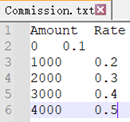4.7 临时维表和区间维表
SQL
SELECT a.CustomerID,a.OrderDate,a.ProductID,a.Quantity,a.Unit,
a.Price,a.Amount,a.EmployeeID,a.EmployeeName,a.ShipVia
FROM Orders a
JOIN (
SELECT ProductID,0.01*sum(Quantity) Quantity
FROM Orders
WHERE OrderDate>='2021-01-01' and OrderDate<='2021-12-31'
GROUP BY ProductID) b
ON a.ProductID=b.ProductID
WHERE a.OrderDate>='2021-01-01' and a.OrderDate<='2021-12-31' and a.Quantity>b.Quantity
SPL
| A | |
|---|---|
| 1 | >st=date(“2021-01-01”), et=date(“2021-12-31”), start=days@o(st), end=days@o(et) |
| 2 | =file(“Orders_Time.ctx”).open().cursor@m(Quantity,ProductID;OrderDate>=start && OrderDate<=end) |
| 3 | =A2.groups(ProductID;0.01*sum(Quantity):Quantity).keys@i(ProductID) |
| 4 | =file(“Orders_Time.ctx”).open().cursor@m(;OrderDate>=start && OrderDate<=end) |
| 5 | =A4.switch(ProductID,A3:ProductID) |
| 6 | =A5.select(Quantity>ProductID.Quantity) |
| 7 | =A6.switch(ProductID).fetch() |
A3 通过分组聚合,算出每种 ProductID 的销售数量的 1%,此时 ProductID 值唯一,因此结果可以当成维表使用
A6 通过关联字段引用维表记录计算
A7 将关联字段恢复成原主键值,取出结果数据
SQL
SELECT sum(Amount* (CASE WHEN Amount<=1000 THEN 0.1
WHEN Amount>1000 and Amount<=2000 THEN 0.2
WHEN Amount>2000 and Amount<=3000 THEN 0.3
WHEN Amount>3000 and Amount<=4000 THEN 0.4
ELSE 0.5 END)
) Amount,EmployeeID
FROM Orders
WHERE OrderDate>='2021-01-01' and OrderDate<='2021-12-31'
GROUP BY EmployeeID
SPL

| A | |
|---|---|
| 1 | >st=date(“2021-01-01”), et=date(“2021-12-31”), start=days@o(st), end=days@o(et) |
| 2 | =file(“Orders_Time.ctx”).open().cursor@m(Amount,EmployeeID;OrderDate>=start && OrderDate<=end) |
| 3 | =file(“Commission.txt”).import@t() |
| 4 | =A3.(Amount) |
| 5 | =A2.join(A4.pseg(Amount),A3:#,Rate) |
| 6 | =A5.groups(EmployeeID;sum(Amount*Rate):Amount) |
A6 产生一个内存区间维表
A8 用 pseg 算出当前记录的 Amount 位于维表的哪个区间段,返回记录序号,再用序号关联
以下是广告时间
对润乾产品感兴趣的小伙伴,一定要知道软件还能这样卖哟性价比还不过瘾? 欢迎加入好多乾计划。
这里可以低价购买软件产品,让已经亲民的价格更加便宜!
这里可以销售产品获取佣金,赚满钱包成为土豪不再是梦!
这里还可以推荐分享抢红包,每次都是好几块钱的巨款哟!
来吧,现在就加入,拿起手机扫码,开始乾包之旅

嗯,还不太了解好多乾?
对润乾产品感兴趣的小伙伴,一定要知道软件还能这样卖哟性价比还不过瘾? 欢迎加入好多乾计划。
这里可以低价购买软件产品,让已经亲民的价格更加便宜!
这里可以销售产品获取佣金,赚满钱包成为土豪不再是梦!
这里还可以推荐分享抢红包,每次都是好几块钱的巨款哟!
来吧,现在就加入,拿起手机扫码,开始乾包之旅

嗯,还不太了解好多乾?





